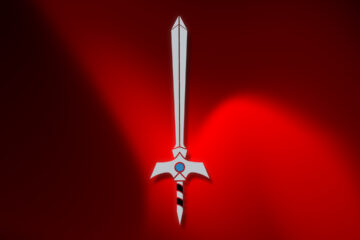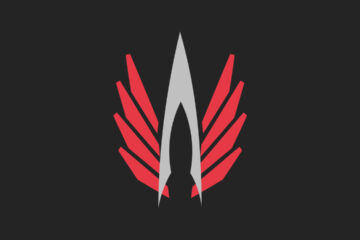THE NIGHTINGALE SUITS
Quartermaster Edram Pertz was assigned one crucial task from the moment he was recruited into Gestalt: To design and build the full-fledged battlefield solution proposal that first drew General Exley’s attention towards him.
To that end, “Eddie,” as he’s often referred to by his teammates, began to draft a new iteration of his conceptual proposal — one that he names “The Gestalt Arsenal.”
He preserved all of the conceptual elements of his original overture: Bleeding edge weaponry, top-notch gadgets, and most importantly, suits far beyond anything else in the world of Orbis. His original plan also called for a so-called “Total Battlefield Operating System,” a highly specialized software solution that would link each element of the Arsenal with one another.
King Sulwyn Starsong and National Intelligence Agency Director James Exley, the benefactors of the Gestalt initiative, both have access to an unknown amount of resources and assets in their repertoire concealed under layers of secrecy most obscure — some of which were put at the disposal of the young Quartermaster.
Director Exley had Edram relocate from his humble and small apartment to a house in one of Ternion’s suburbs, a house that at plain sight, seems to be no different than the ones in its vicinity. However, its basement is equipped with a state of the art workshop that had everything Edram required to begin working on his giving tangible form to his dream.
The “Battle Suits” were the centerpiece of Edram’s proposal for Gestalt. Director Exley provided Edram with an ostentatious (but not unlimited) budget, a reasonable time frame of no more than a year, and a series of objectives to aim at when designing and creating the suits — as such, a working prototype was the first order of business.
With his conceptual — but by no means combat-capable — PeRTZTech-BSX0 Battle Suit accompanying him like a silent guardian, the pictures of his late father Edorath Pertz next to his desk, and the legacy of the Nasivern armors of eld so vividly present in his thoughts, Edram spent countless nights drawing, calculating, and imagining — before he knew it, three months had passed, yet he still had nothing concrete to show.
Disheartened, Edram began to doubt himself. Perhaps he he had overestimated himself, oversold his abilities to Exley, and presented a dream far too large in scope for a single man to craft alone with his hands.
Nonetheless, and after regaining his resolve through prayer and a few too many cups of hot chocolate, he remained resolute that he was up to the task. After several marathonic sessions and copious amounts of junk food and caffeine, he came up with several conceptual designs for what would be the BS-10x line of suits.
Some of those initial designs featured a full alloy frame, a bulky and clunky design featuring varied shapes and forms — “not good enough,” he was unconvinced by any of the initial batch of designs that his mind concocted.
Edram discarded them and began from scratch, starting a new project on his computer from scratch. The new project, he wrote in one of his many physical and digital notes, had the following goals in mind:
First and foremost, the suit needed to provide a significant boost to the user’s combat strength and speed, a non negotiable goal. At the same time, the suit also needed to provide superb armor and resistance while also being as lightweight as possible. If it’s too heavily taxing then it’d just impair the user’s mobility and negating any potential speed benefits, and he couldn’t have that.
As such, the suit would not feature a full body frame of armor like his initial draft designs did, but rather, it would feature an underlying highly resistant bodysuit with a series of segmented alloy plates on the chest, back, and limbs.
The helmet would have to be visually stunning, capable of “striking fear at the hearts of those that would dare cross paths with the wearer.” Keeping that in mind, though, any “cool factor” in the design should never come at the expense of its user’s field of view. Additionally, a clean heads up display was a requirement, to be handled by the eventual Operating System.
The Operating System had to provide the wearer with a myriad of information and features, from weapon ammunition status to navigation, target marketing, communications, and other forms of information via the use of augmented reality, never at the cost of visual clarity.
Being the first of its kind — as the X0 Battle Suit was pretty much just a conceptual mock up “costume” not suited for combat and whose features were merely simulated, Edram wanted to design the BS-10x suits with scalability in mind.
The ability to upgrade the basic suit and equip it with specialized gadgets and “add-on” equipment would definitely make the proposed BS-100 prototype a very adaptable suit.
With a solid road plan on his hands, Edram was only missing a name for the suit. After much deliberation he settled for “Nightingale.”
Work on the prototype suit began in tandem with the accompanying software modules that would eventually become “Gestalt OS” or gtOS. After another three months of arduous labor, Edram had a finished prototype suit ready to present to Exley: The first prototype Nightingale suit.
The underlying bodysuit was made of a sleek, resistant, and flexible material. “Layered mesh plating,” he said to the Director when he presented it. It grants the wearer unrestricted movement and a high grade of protection against blunt impacts and most common forms of firearm ammunition.
A complex array of wires and sensors were meticulously woven into the bodysuit; these sensors provide all sorts of performance and biometric data to be processed by the suit’s systems, which are housed on the helmet.
The front of the chest featured three sharp and symmetrical armor plates. The unique alloy that the plates were made of was created via a meticulous and arduous process that the Nasivern used to employ — a process that Edram adapted and modified around the limitations of Vaifen’s technology and available substitute materials, with the end result being as “close to the original” as he could but “quite far from the original.” On the backside, three segmented plates offer protection; holsters can be mounted in between each plating for firearms and melee weaponry.
The suit’s limbs feature angular and sharp armor plating that are similar to the chest’s, while the two shoulder plates sport a rounder design that allow for unrestricted movement. The suit’s full closed helmet is mostly made of the same alloy used in the suit’s armor plates, making it exceptionally resistant. It features a sleek and sharp visage, with a featureless mouthpiece, and menacing-looking eyes that illuminate in a bright blue hue. A V-shaped crest is featured on the forehead — it’s not just an aesthetic choice made by Edram, it conceals two high range antennas that the suit uses for communication.
Edram also provided the suit with a belt, its buckle has an angular pattern inherited from the suit’s plating. Additional hardware is housed on the belt, including an auxiliary processor and subsystems that complement the helmet’s hardware in case of failure. The Nightingale Suit is powered by an ingenious array of flexible batteries that are distributed all across the chest, back, helmet, legs, and arms.The arms and back contained a series of connectors that would eventually be used for Edram’s modular gadget and “add-on scalability” plans.
Director Exley was more than pleased with the prototype suit. From the design to the theoretical enhancements in performance that it would grant the wearer. Edram’s months of hard work had yielded results worthy of being proud, and his unbound creativity and talents had resulted in astonishing results worthy of the recognition of the Nasivern engineers of yore.
The suit, serialized as GT-BS100, was finished around the time Commander Erron Leitner was recruited to serve as the team’s leader. Unfortunately, there was a sheer size and shape discrepancy between the prototype — fit for an average-sized person — and Erron’s tall and strong physique. As a result, Edram had no choice but to build a second suit more tailored to Erron’s measurements, which he gave the name of GT-BS101MA.
The idea of assigning each member a color came halfway through the Gestalt recruitment process. Commander Erron Leitner, the leader of what would soon become Gestalt’s strike team, sided with Edram’s chromatic proposal, donning a blue color on his recently finished suit.
As the Ashen Reckoning increased the frequency of its attacks and the time for action kept getting cut short, the modular features that Edram Pertz initially envisioned for the Nightingale Series were scrapped, and are thus absent from the rest of the suits — including Erron’s.
Nonetheless, vestiges of those features can be found within both the Suit and the Operating System’s codes.
A more simplified implementation of the idea served as the basis for the SED Hawk Drone pack that’s currently only compatible with the original prototype suit, which was scaled down, modified, and assigned to Cameron Bennett, the team’s tech specialist. Cameron chose to bathe her suit in pink.
And thus, the first generation of Gestalt Battle Suits came to be. The Nightingale Series consists of five suits: the Initial prototype suit — now pink-colored, and four more: Blue, Yellow, Green, and Red. Edram’s ambitions were high, higher than the end result, regardless, he’s proud of his work, which is undoubtedly second to none.
The Nightingale suits not only communicate with one another in real time, they can share resources and processing power if needed. The suits are able to relay and bounce signals from one suit to another. Access to a high speed hidden communications channel was granted to the project so that Gestalt’s Operations Room and the wearers of the suit can be connected in real time in both audio and video without experiencing network bottlenecks.
In order to make up for the removal of the modular upgrades, which would’ve been one of the Nightingale suits’ strongest assets, Edram began to experiment with a replacement feature, something he called the Overdrive Burst feature, an “ace up one’s belt” according to him — this feature is still highly experimental and untested. The Overdrive Burst can be automatically activated by voice, or manually via each suit’s belt in case of a helmet failure.
Following the teachings and traditions of the Nasivern that came before him, Edram is aware that despite the technological superiority that his suits can achieve, they’re only metal and circuitry. The warrior’s soul — the missing component that his technology lacks — is what their eventual wearers will provide.
Combining both his technology with the indomitable and unyielding fighting spirit of a soldier is, in Eddie’s eyes, a path to victory.
The unbound spark of creation that is Edram Pertz does not rest on his laurels. Even though the Nightingale suits are yet to see their fair share of use he’s already begun developing a second generation, much more ambitious and fine-tailored than the Nightingale suits themselves.
Sword of Vaifen is a work in progress. Things are not set in stone and can be subject to change.
Every image, logo, and any other graphics that you see here are placeholders, none of them are final.
2024, by Christian Kaleb Caruzo.


